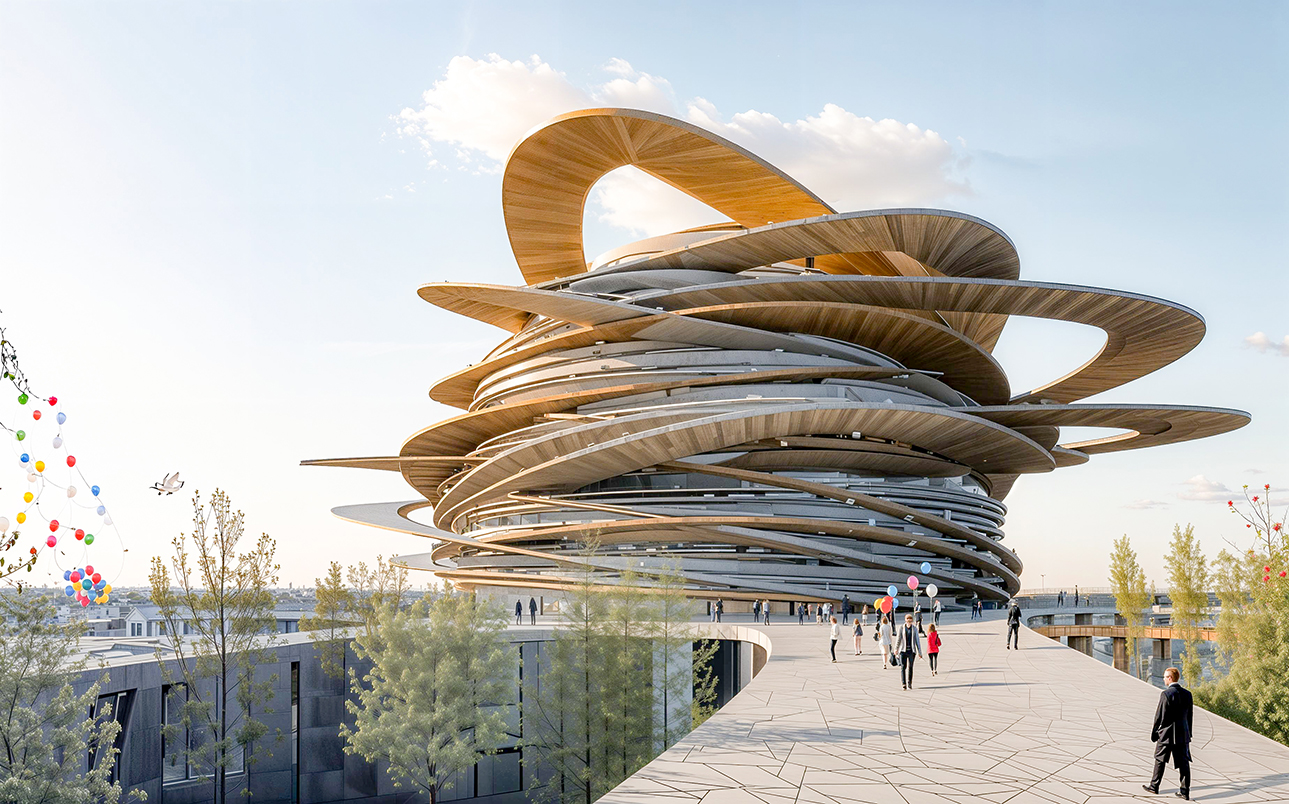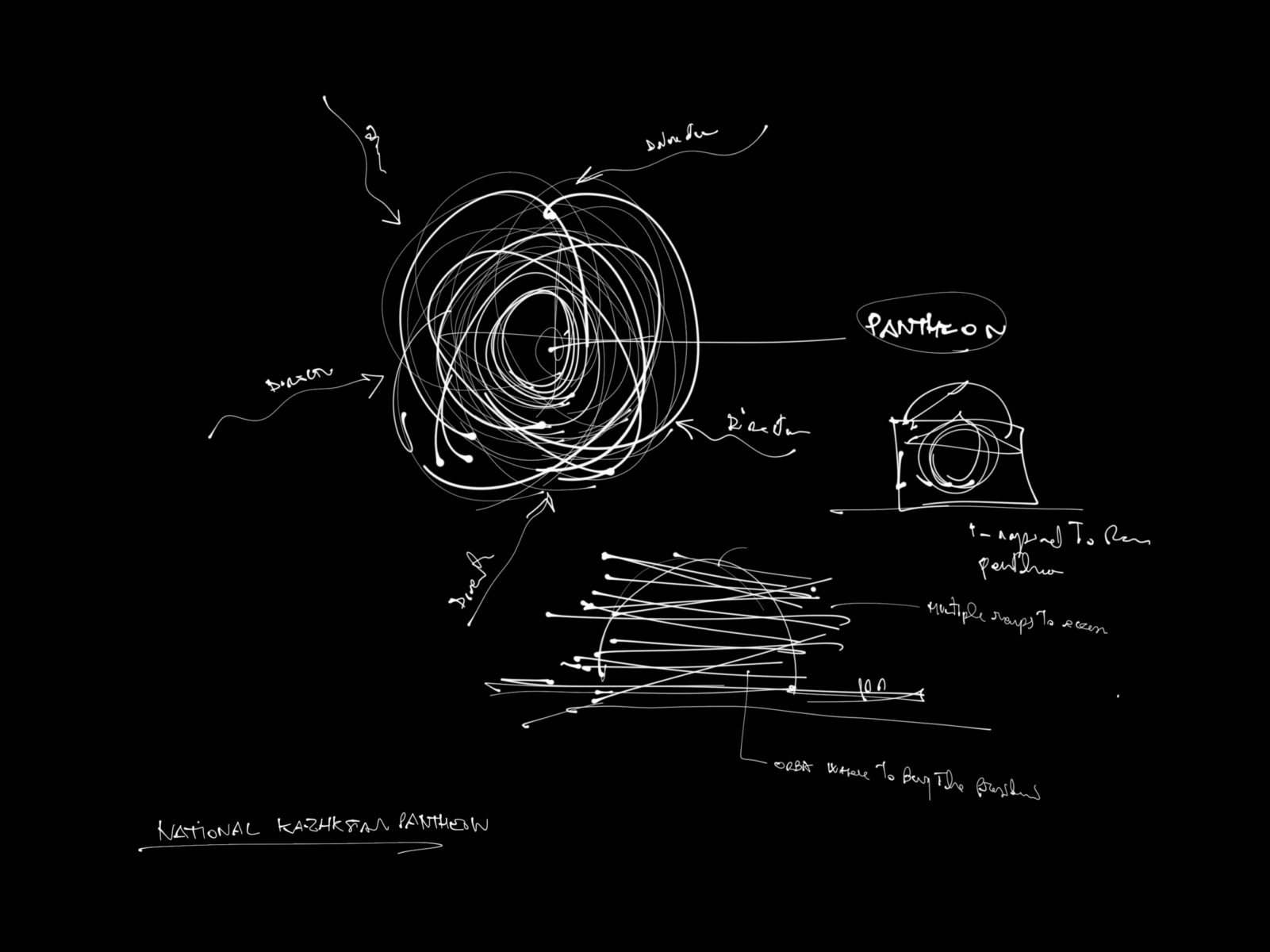Kazakhstan National Pantheon
The National Pantheon will be built on a large area, 17 km south of the city and inside a natural environment that is still an undeveloped land.
Our design originates directly from this land. A serie of walkways paths and stripes connects the Pantheon building to the land where it is located and this is a methaphor of patriotic attachment to the land of the whole Kazakhestan.
The Pantheon is the core of the project. It is a large sphere with maximum height of 55 meters from the ground level and maximum width 70 meters. We used as model the first and most famous “Pantheon” in History: The Pantheon of Rome, the ancient temple of all the Roman Emperors that was the place of the “Ascensions”, the ceremony in which the Emperor, after death used to be taken by the Eagles and driven up to the sky in order to become a God.
For this reason the “Rome Pantheon” had a large hole at the top of the sphere, so that Eagles could do their job and carry up the emperor. Our project is a sphere with the same hole on top as the Rome Pantheon which is the architectural models for all the further other pantheons in hiatory, including the one in Paris.
The spherical shape configures a central and monumental space where the point in the center gains a powerful focus and all the points around are subdued to it. We imagine the center point to host the bury of the biggest hero of Kazakhestan.
Our Pantheon is concepted as the meeting point of the all religions of Kazakhestan. All the people from all the religions and cults come to the core from all sides of the country and gather in the monument in the center by accessing the site through the several stripes-connectors.
The final result is a dynamic complex that appears as a “GALAXY” from the top view. The architecural scope is to show the energy of people in movement torward the center.
The movement of a large number of visitors on line to visit and commemorate the national heroes will provide a strong energy to the core. This place inside the sphere will be the container of all this energy gathered and the central hall where the major heroes will be buried will be the fulcrum of the KAzaki patriotic feeling. Here people will be allowed to stop, think about the heroes life, commemorate and pray for them. By doing this everybody will have the feeling to be part of a whole united country. Catholics will come from West side on which direction is Rome, the spiritual center of the Catholicism. Christian ortodoxes will come from North West, from Moscow; Jewish will arrive from South West, as per Jerusalem; Muslim from Mec, buddhists will arrive from South-East as per Tibet.
Each cult will have its own religious hall for ceremonies and a double indoor-outdoor walkway. The indoor walkway is on two levels and visitors can freely pass throu on the upper level that lead to the Pantheon or visit the basement level where the heroes are buried in the deep of a massive stone wall.
The north wing is the main entrance that drive to a ring way from which to be connected to all the other wings and above all to get access to the inner monumental hall: the Pantheon.
Inside the Pantheon a marble and gold disk is suspended in the center on top of the crypta with the major heroes buried which is on the basement.
The space is wide and symmetric. The dome is made of a large serie of haloes that intersect each other. Some of this haloes are helicoidal ramps that allow a wide number of people to assist ceremonies by watching from top and have an incredible panoramic view of both the interior space and outside landscape. From here it is possible to observe the whole monumental complex and feel as part of something
amazing. Light goes through the haloes and enter the dome from all sides but is cut in single rays that breakthrough the darkness.
At night the haloes are lighted up and become shining rings visible from very far. The monumental complex is completed by an administrative wing on the south side with the offices and the restauran court. Some pedestrian walkways connect the complex to the parking area outside. Another walkway lead to the Kabanbai Batyr mausoleum.
The most used material would be stone, marble and gold-bronzee for walls and flooring while insuating glass would be in several exterior partitions.
Landscape is arranged by tematic gardens related to the different religious blocks. For example a zen garden is design as a spiritual outdoor and a italian style garden, which is typical of the catholic cemeteries would accomplish the outdoor space related to the Catholic cult’s wing.
Stone is definitely the most common material for monumental complexes and we base most of our finishing design on it.
The complex is design to be also seen from the airplane as it is on one of the main routes of traffic for airlines coming from south. The Astana’s airport is on the way and it would be important to also have a direct impact on the foreign visitor coming to Kazakhestan.
Location / Astana | Kazakhstan
Year / 2014
Client
/ National Government of KazakhstanStage
/ design competition entryLot area
/ 50.000 sqmTeam di Progetto
Design Team
/ Obicua + O.C.R.A. + 3+1 AssociatiImage credits / ©BICUADRO











